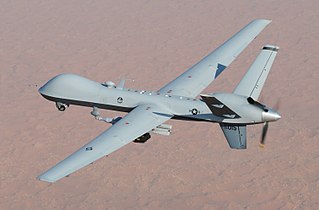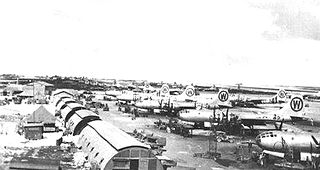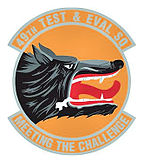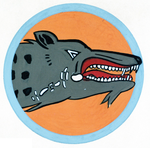
The 95th Reconnaissance Squadron is a squadron of the United States Air Force. It is assigned to the 55th Operations Group, Air Combat Command, stationed at Offutt Air Force Base, Nebraska. The squadron is equipped with several variants of the Boeing C-135 aircraft equipped for reconnaissance missions.

The 26th Space Aggressor Squadron is a unit of the United States Air Force located at Schriever Air Force Base, Colorado. It is part of the 926th Group and is the reserve associate of the 527th Space Aggressor Squadron.

The 13th Bomb Squadron is a squadron of the United States Air Force. It is assigned to the 509th Operations Group, Air Force Global Strike Command, stationed at Whiteman Air Force Base, Missouri. The squadron is equipped with the Northrop Grumman B-2 Spirit Stealth Bomber.

The 20th Bomb Squadron is a unit of the 2d Operations Group of the United States Air Force located at Barksdale Air Force Base, Louisiana. The 20th is equipped with the Boeing B-52H Stratofortress.

The 93rd Bomb Squadron, sometimes written as 93d Bomb Squadron, is a squadron of the United States Air Force Reserve. It is assigned to the 307th Operations Group of Air Force Reserve Command, stationed at Barksdale Air Force Base, Louisiana. The squadron is equipped with the Boeing B-52H Stratofortress, and is the Air Force's B-52 Formal Training Unit (F.T.U.).

The 73rd Special Operations Squadron is a unit of the United States Air Force, assigned to the 1st Special Operations Wing at Hurlburt Field, Florida. The squadron operates the AC-130J Ghostrider ground-attack aircraft in support of Air Force Special Operations Command.

The 911th Air Refueling Squadron is part of the 305th Operations Group, and is stationed at Seymour Johnson Air Force Base, North Carolina. The squadron was the Air Force's first active duty squadron under the command of a reserve wing. In October 2016, the 911th, formerly geographically separated from the 6th Air Mobility Wing at MacDill Air Force Base, Florida and operated as the active duty associate to the 916th Air Refueling Wing, became the first "I-Wing" or Integrated Wing. In July 2020, it was reassigned to the 305th Operations Group at the McGuire AFB entity of Joint Base McGuire–Dix–Lakehurst, New Jersey.

The 48th Flying Training Squadron is part of the 14th Flying Training Wing based at Columbus Air Force Base, Mississippi. It operates T-1 Jayhawk aircraft conducting flight training. The squadron is one of the oldest in the Air Force, being formed during World War I as the 48th Aero Squadron on 4 August 1917.

The 72d Test and Evaluation Squadron is part of the 53d Wing at Eglin Air Force Base, Florida. The squadron is geographically separated but is operated from Whiteman Air Force Base, Missouri. It conducts testing and evaluation of the B-2 Spirit aircraft.

The 436th Training Squadron is a non-flying training squadron of the United States Air Force. The 436th Training Squadron, located at Dyess Air Force Base, Texas, is a geographically separated unit within Air Combat Command’s 552nd Air Control Wing, at Tinker Air Force Base, Oklahoma.

The 429th Attack Squadron is a classic associate squadron, stationed at Holloman Air Force Base, New Mexico. It is geographically separated from its parent 926th Wing at Nellis Air Force Base, Nevada.

The 49th Aero Squadron was a United States Army Air Service unit that fought on the Western Front during World War I.

The 491st Attack Squadron is an active United States Air Force regular associate unit, stationed at Hancock Field Air National Guard Base, where it was activated in April 2019. It is assigned to the 49th Wing at Holloman Air Force Base, New Mexico and operates General Atomics MQ-9 Reaper unmanned aerial vehicles.

The 50th Attack Squadron is a squadron of the United States Air Force, stationed at Shaw Air Force Base, South Carolina, where it operates the General Atomics MQ-9 Reaper unmanned aerial vehicle. It is assigned to the 25th Attack Group, also at Shaw, and is a component of the 432d Wing, located at Creech Air Force Base, Nevada.

The 492d Attack Squadron is an active United States Air Force unit. It is assigned to the 49th Operations Group, stationed at March Air Reserve Base, California. It was reactivated on 15 April 2019.

The 482nd Attack Squadron is a United States Air Force unit, stationed at Shaw Air Force Base, South Carolina, where it is an operational squadron of the 25th Attack Group, operating the General Atomics MQ-9 Reaper unmanned aerial vehicle.

The 484th Bombardment Squadron is an inactive United States Air Force unit. It was last assigned to the 505th Bombardment Group at Clark Field, Philippines, where it was inactivated on 10 June 1946.

The 22d Intelligence Squadron is a non-flying squadron of the United States Air Force. It is assigned to the 691st Intelligence, Surveillance and Reconnaissance Group, Fort George G. Meade, Maryland.

The 166th Aero Squadron was a United States Army Air Service unit that fought on the Western Front during World War I.

The 54th Airlift Squadron is a United States Air Force squadron stationed at Scott Air Force Base, Illinois. The squadron is an active duty associate unit aiding the 932d Airlift Wing in performance of its airlift mission. The first predecessor of the squadron was formed in August 1917 as the 54th Aero Squadron and served in France during World War II. In 1936, this unit was consolidated with the 54th School Squadron, a pilot training unit that became the 54th Bombardment Squadron, which became a demonstration unit for the Air Corps Tactical School, and later a test and evaluation unit for medium bomber aircraft and tactics.




























